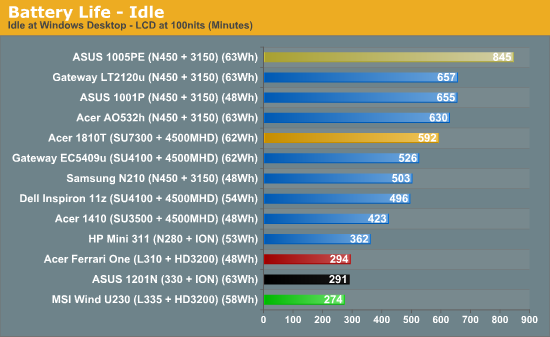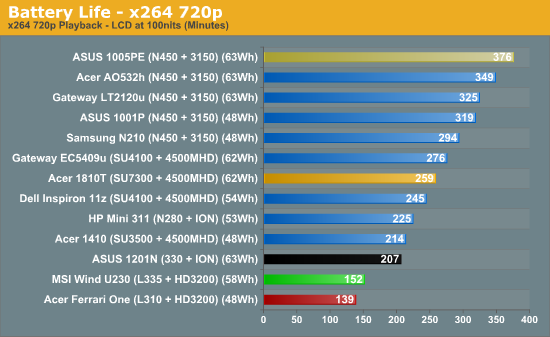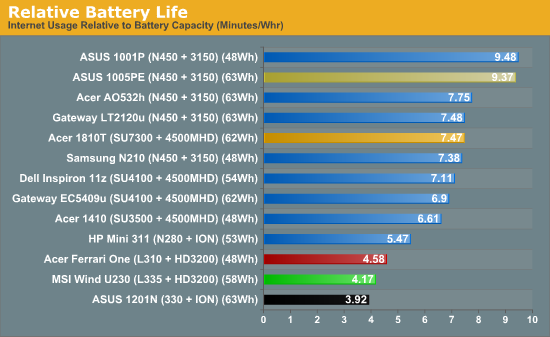MSI Wind U230: One Last Hurrah for the AMD Athlon Neo X2 Congo
by Dustin Sklavos on August 4, 2010 7:00 PM EST- Posted in
- Laptops
- AMD
- MSI
- U230
- Athlon Neo X2
Battery Life and a Wrinkle or Two
Unfortunately, the improved performance of the L335 exacts its price in blood. Specifically, the blood of your battery.




It's pretty dismal. A machine this small begs to be off the chain, but here AMD's power-hungry Congo platform makes its presence known, ensuring a useful lifetime on the battery of a shade over three hours. That's about enough to get through one lecture in a class, but it's inexcusable for a machine that's otherwise so small. And when 720p playback is brought into the picture, battery life dips under three hours.
What's interesting, however, is discovering how AMD handles their power savings on the Athlon Neo X2 L335. Simply put, they don't. While researching this notebook and others that use Athlon Neo processors, many other users have tried to squeeze more battery life out of AMD's hardware and met with some success. That success stems from undervolting the processor using RMClock, and it's actually pretty effective at adding a good half hour or so to the battery.
A major part of the problem seems to be that AMD volts the Athlon Neo X2 extremely aggressively. Our review unit has a standard voltage of one volt on the processor, and that voltage is consistent regardless of the clock speed the chip is running at. That means that whether the chip is running at full tilt 1.6 GHz or the more "power economical" 800 MHz, it has the exact same amount of voltage coursing through it, throwing heat and spinning up the fan.
Using a combination of RMClock and IntelBurnTest, we were able to bring the voltage of the processor at 1.6 GHz down to just .825V, a substantial .175V difference, and at each multiplier step we were further able to reduce the voltage of the chip by at least .025V. It's a major improvement; when testing stability at 1.3 GHz with a voltage of .75V using the gruelling IntelBurnTest, we found the system fan barely span up more than its usual hum and certainly didn't get anywhere near as loud as it did at the full volt. If anything it's a shame the chips don't ship better tuned from the factory, because they're clearly capable of performing at least a little better and a little more efficiently.










32 Comments
View All Comments
shabby - Wednesday, August 4, 2010 - link
Maybe if this was $299 it might sell, i just cant imagine anyone paying this much to get such shoddy battery life.Dustin Sklavos - Wednesday, August 4, 2010 - link
You're not paying for the battery life, you're paying for the performance and form factor.vol7ron - Wednesday, August 4, 2010 - link
so basically a "keep it plugged in like a desktop...and if you have to move from your bed to the couch, it won't die on you between plugs"?wintermute000 - Wednesday, August 4, 2010 - link
Way to troll, boy genius. Since when has 4 hours been in the 'keep it plugged in like a desktop' ballpark?RamarC - Wednesday, August 4, 2010 - link
gotta agree that $479 for so-so battery life is too much regardless of the compact form factor. heck, i just got a core-i3 14" laptop that has almost 4 hrs battery life for $499.shabby - Thursday, August 5, 2010 - link
What performance? It can barely keep up with the culv laptops.Dustin Sklavos - Thursday, August 5, 2010 - link
It beats the tar out of Atom, CULV laptops are barely in its price bracket (please don't quote me refurbs on NewEgg), and Intel's IGP sucks royally compared to the HD 3200 in the U230.dmjazzijeff - Wednesday, August 4, 2010 - link
Dustin, by fiddling with the voltages and such, did you notice any appreciable gain in battery life? The drop in temps would be nice, of course, but increased battery life would be nice as well. I realize that the majority of a portable's power consumption is the screen and rotating media - I'm curious how much of this laptop's so-so battery life is processor related.megakilo - Wednesday, August 4, 2010 - link
I would really like to see some results and reviews of the new Nile platform. The Congo platform uses a K8 CPU. Nile has a 45nm K10 processor.whatthehey - Wednesday, August 4, 2010 - link
Isn't that what they said in the conclusion? Interesting laptop, and at least it's not the putrid pile of feces that the Ferrari One is, but for $480 it needs to do more than outperform Atom. CULV performance and battery life with a decent IGP is what we're looking for.